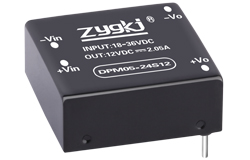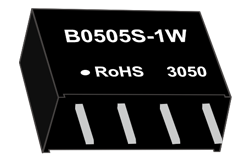ข่าว
Bidirectional DC DC Converter: Principles, Topologies, and Applications
Author: ZYG Power Module Time: 2023-6-24
A bidirectional DC-DC converter is a power electronic device that can transfer electrical energy bidirectionally between two DC voltage levels. It is widely used in various applications, including electric vehicles, renewable energy systems, and battery energy storage systems. This article will explore the principles, topologies, and applications of bidirectional DC-DC converters.
Principles of Bidirectional DC-DC Converter
The main function of a bidirectional DC-DC converter is to transfer power from one DC voltage level to another. The power transfer can be either unidirectional or bidirectional. A bidirectional converter can transfer energy from a high voltage source to a low voltage load and vice versa. Bidirectional DC-DC converters typically consist of two power converters, each with its own power switch and control circuit. One converter operates in the forward direction, transferring energy from the input voltage to the output voltage, while the other converter operates in the reverse direction, transferring energy from the output voltage to the input voltage.
The operation of a bidirectional converter is controlled by a feedback loop that adjusts the duty cycle of the power switches to maintain the desired output voltage level. The duty cycle determines the amount of time the power switch is on during each switching cycle. By adjusting the duty cycle, the output voltage can be regulated to a desired level.
Topologies of Bidirectional DC-DC Converter
There are several topologies of bidirectional DC-DC converters, including full-bridge, half-bridge, and interleaved. Each topology has its advantages and disadvantages, and the choice of topology depends on the specific application requirements.
The full-bridge bidirectional DC-DC converter is a popular topology used in high-power applications. It consists of four power switches arranged in a bridge configuration. In the forward direction, the input voltage is applied across the diagonal of the bridge, while the load is connected across the other diagonal. In the reverse direction, the input and output terminals are swapped, and the converter operates in the opposite direction.
The half-bridge bidirectional DC-DC converter is a simpler topology that uses two power switches. In the forward direction, the input voltage is applied across one switch, while the load is connected across the other switch. In the reverse direction, the input and output terminals are swapped, and the converter operates in the opposite direction.
The interleaved bidirectional DC-DC converter is a more complex topology that uses multiple power converters in parallel. This topology has the advantage of reducing the input and output current ripple and improving the overall efficiency.

Applications of Bidirectional DC-DC Converter
Bidirectional DC-DC converters are widely used in various applications, including electric vehicles, renewable energy systems, and battery energy storage systems. In electric vehicles, bidirectional converters are used to transfer energy between the battery pack and the vehicle\’s electrical system. The converter can charge the battery pack when the vehicle is braking or decelerating, and it can discharge the battery pack to power the vehicle\’s electrical system when accelerating.
In renewable energy systems, bidirectional converters are used to transfer energy between the DC voltage level of the renewable energy source, such as a solar panel or wind turbine, and the DC voltage level of the load or the battery storage system. The converter can also transfer energy from the battery storage system to the load when the renewable energy source is not available.
In battery energy storage systems, bidirectional converters are used to charge and discharge the battery pack. The converter can charge the battery pack when excess energy is available from the grid or a renewable energy source, and it can discharge the battery pack to supply power to the load when needed.
Conclusion
In summary, bidirectional DC-DC converters are important power electronic devices that can transfer energy bidirectionally between two DC voltage levels. They are widely used in various applications, including electric vehicles, renewable energy systems, and battery energy storage systems. The choice of topology depends on the specific application requirements, and the operation of the converter is controlled by a feedback loop that adjusts the duty cycle of the power switches to maintain the desired output voltage level.
ก่อนหน้า: ZP Series AC DC Converter – Efficient Power Conversion Solutions
ต่อไป: Medical Power Series: Empowering Healthcare Professionals and Patients for Better Health
ข้อมูลที่เกี่ยวข้อง
-
2023-7-17
China HP Series supplier: The Ultimate AC DC Converter Solution
Introduction: HP Series is a revolutionary AC DC converter solution that provides unmatched efficiency, reliability, and versatility for various applications. Designed by a team of experts at our state-of-the-art facility, this cutting-edge converter solution is set to redefine power conversion technology. In this article, we will explore the features and benefits of the HP Series and delve into its impact on different industries. 1. Unparalleled Efficiency: The HP Series boasts exceptional efficiency levels, thanks to its advanced power conversion architecture. With a conversion efficiency of up to 98%, it ensures minimal power loss during the conversion process, resulting in significant energy savings. This efficiency makes it an ideal choice for industries striving to reduce their carbon footprint and operating costs....
ดูรายละเอียด -
2023-12-8
Module Power Supply: Ensuring Efficient and Reliable Power for Your Devices
In today's fast-paced and technology-driven world, the demand for efficient and reliable power supply has never been greater. From smartphones and laptops to household appliances and industrial equipment, all modern devices require a stable and uninterrupted power source to function optimally. This is where module power supply comes into play. In this article, we will explore the importance of module power supply in ensuring efficient and reliable power for your devices. What is Module Power Supply? A module power supply, also known as a power module or a power converter, is an electronic device that converts electrical energy from one form to another and delivers it to various components of a device. It takes the input voltage from a power...
ดูรายละเอียด -
2023-4-20
Creating an AC-DC Power Supply: A Comprehensive Guide
An AC-DC power supply is a device that converts alternating current (AC) to direct current (DC). It is used in a wide range of electronic devices such as computers, televisions, and mobile phones. In this guide, we will provide you with a comprehensive guide on how to create your own AC-DC power supply. Step 1: Determine Your Requirements Before you start building your power supply, you need to determine your requirements. Ask yourself the following questions: - What voltage do you need? - What current do you need? - What is the input voltage? - What is the output voltage? Step 2: Choose a Transformer The transformer is an important component of the AC-DC power supply. It converts the incoming...
ดูรายละเอียด -
2023-10-19
AC/DC Power Supply Module: A Reliable Solution for Stable Power Output
Introduction: In today's technologically advanced world, power supply plays a crucial role in ensuring the smooth functioning of various electronic devices. From smartphones to computers, every device requires a stable power supply to operate efficiently. One such reliable solution for stable power output is the AC/DC Power Supply Module. This article will delve into the features, benefits, and applications of this module, highlighting why it is an ideal choice for various industries. Features of AC/DC Power Supply Module: 1. Stable Power Output: The AC/DC Power Supply Module is designed to deliver a stable power output, ensuring that electronic devices receive the required voltage without any fluctuations. This stability prevents damage to sensitive components and ensures consistent performance. 2. Wide Input...
ดูรายละเอียด -
2022-10-17
วิธีซื้อตัวแปลง DC-DC และใช้งานอย่างไร
เมื่อมองหาตัวแปลง DC-DC สิ่งสำคัญคือต้องพิจารณาความต้องการของคุณและเลือกตัวแปลงที่เหมาะสมกับงาน มีตัวแปลงที่หลากหลายในตลาด ดังนั้นการทำวิจัยของคุณและค้นหาตัวแปลงที่ตรงกับความต้องการของคุณจึงเป็นสิ่งสำคัญที่สุด ตัวแปลง DC-DC คืออะไร? ตัวแปลง DC-DC (กระแสตรงเป็นตัวแปลงกระแสตรง) เป็นตัวแปลงอิเล็กทรอนิกส์ที่แปลงอินพุตกระแสตรง (DC) เป็นเอาต์พุตกระแสตรง ตัวแปลง DC-DC มักใช้เพื่อแปลงแรงดันไฟฟ้าจากแบตเตอรี่เป็นระดับที่เหมาะสมสำหรับการจ่ายไฟให้กับอุปกรณ์อิเล็กทรอนิกส์ ตัวแปลง DC-DC ยังใช้ในอุปกรณ์จ่ายไฟเพื่อแปลงแรงดันไฟฟ้าอินพุต AC เป็นแรงดันเอาต์พุต DC อะไรคือ...
ดูรายละเอียด -
2023-4-23
Distinguishing Between AC and DC Power Supplies
AC and DC power supplies are two types of electrical power sources commonly used in various applications. AC stands for alternating current, while DC stands for direct current. The main difference between the two is the direction of the flow of electrons through the circuit. In this article, we will discuss the differences between AC and DC power supplies in terms of their characteristics, applications, and advantages. Characteristics of AC Power Supplies: AC power supplies provide electrical power that changes direction periodically. The voltage and current in an AC circuit oscillate sinusoidally, which means that they change direction and magnitude constantly. The frequency of this oscillation is measured in Hertz (Hz) and is typically 50 or 60 Hz in most...
ดูรายละเอียด


















